William Griffin and Rachel Louisa Cooper were my paternal grandmother's parents. This document attempts to summarize important events
in their lives, as well as the lives of their family members.
Contents
Rachel Cooper's Parents
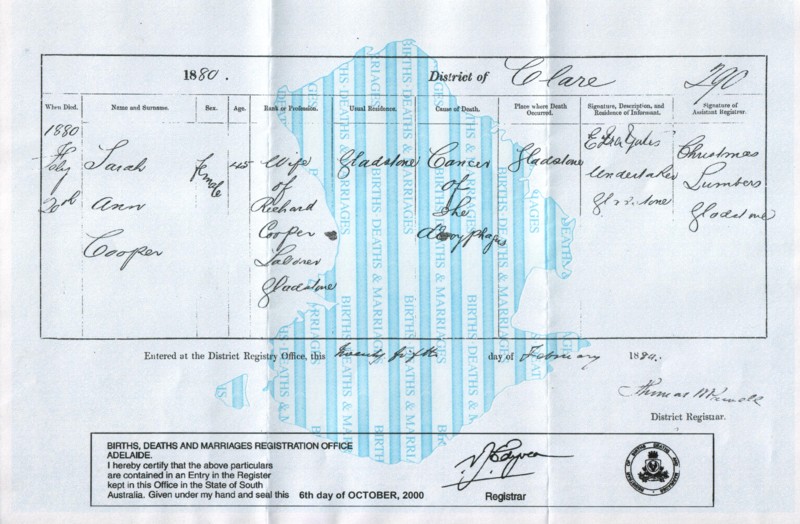
Sarah Anne Cooper's death certificate.
Rachel Louisa Cooper's parents were Richard Cooper and Sarah Ann Williamson. Richard and Sarah Ann were born and married in
Leicester, England. Their first son, Henry, was born in Leicester in
1859. By 1861 the family had relocated to Birmingham. Their second son John Edward Cooper was born there in 1863. On 9 June 1866 the family
embarked from Plymouth on the Hougoumont as government assisted emigrants to South Australia. The Hougoumont arrived in Port Adelaide 100 days later in a gale on 16 September 1866.
Richard and Sarah Ann's third child, and first daughter, Amelia Rickards Cooper was born in Hindmarsh, South Australia, on
22 June 1868.
On 22 September 1873 Rachel was born in the small town of
New Hamburg (now known as Willyaroo), South Australia. Willyaroo is about 60km south east of Adelaide, and is adjacent to
Strathalbyn.
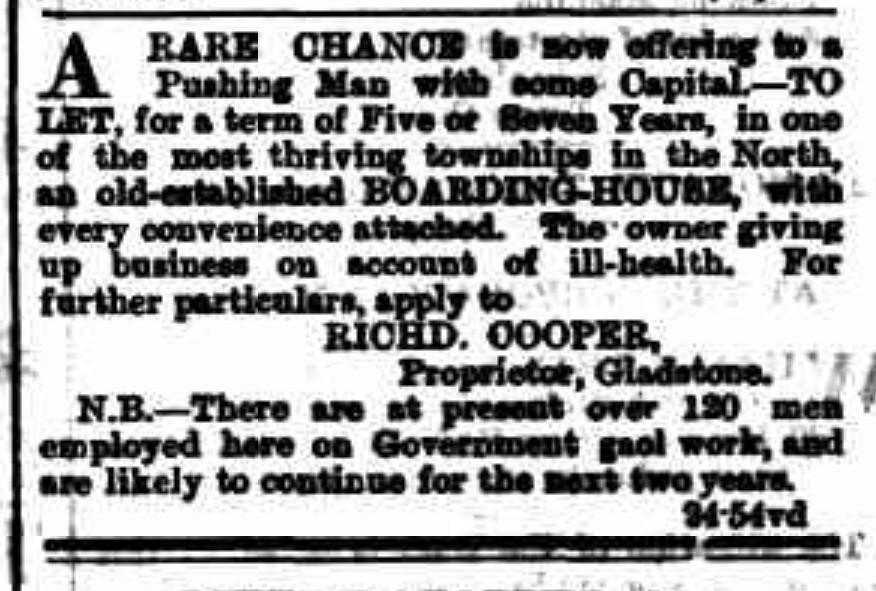
Richard Cooper's "Pushing Man" advertisement ran in South Australian newspapers for two months prior to Sarah Ann Cooper's death.
On 20 February 1880, at age 48, Rachel's mother Sarah Ann Cooper died of esophageal cancer. The family was living in the remote town of
Gladstone, approximately 200km north of Adelaide. Sarah Ann was likely the
proprietor of a boarding house, and upon her death the business was sold. Sarah Ann was buried in the Gladstone Cemetery.
Richard Cooper Remarries, becomes Joseph
Slightly more than three months after his wife's death, on 5 June 1880, Richard Cooper remarried in Gladstone. Richard's new wife was
Elizabeth Frick, formerly Elizabeth Warner. Elizabeth had been
in a previous relationship with Louis Henry Frick, and they had
two children, David (born
1870) and Louis William James Frick (born 1872), however they were
not married and at some point around 1872 they separated. In 1873 Elizabeth sued
Louis Henry for support, however her case was dismissed because she was unable to produce a marriage certificate. Later, Louis
Henry Frick married Fanny Lines, moved to Wilmington, South Australia, and had a
large second family.
In 1878, Elizabeth's sons David and Louis, small boys at the time, were charged
with being neglected children in Adelaide and were sent to the Industrial School for a month.
Around the time he remarried, Richard Cooper, for unknown reasons, changed his name to Joseph Cooper. Joseph Richard Cooper and
Elizabeth's first daughter, Sarah Ann Cooper, was born in
Gladstone on 27 June 1881. Sarah Ann was most likely named after Richard's late wife. In 1883 Joseph Richard and Elizabeth's second
child and first son, Joseph Talbot Cooper, was born in
Rosewater, South Australia, near Port Adelaide. In 1885 Rose
Elizabeth Cooper was born in Port Adelaide.
The Cooper Family Moves to Melbourne
Around 1885 Joseph, Elizabeth and most of the younger members of the Cooper family moved to Melbourne.
Henry, Joseph Richard's eldest son, is hard to track, so it's unclear if he was with the family at this time. John Edward Cooper,
Joseph Richard and Sarah Ann's second son likely stayed in South Australia. John married Emma Jacob in 1893 in South Australia, and
eventually moved to Horsham, Victoria, where he and Emma raised a large family. John Edward Cooper died on 25 November 1931 and is buried in the Horsham Cemetery. Amelia Rickards Cooper
has been difficult to track, but it is likely she remained in Adelaide.
Joseph Richard and Elizabeth had two more children. Charles Edward Cooper was
born in South Melbourne in 1887, and Lillian Flora Violet
Cooper was born in 1891 in South Melbourne.
On 2 November 1891 Rachel's father, Joseph Richard Cooper died in South Melbourne at age 58. His occupation was Wharf Laborer. The
cause of death was bronchitis and asthma. Rachel signed as the informant on her father's death certificate. Joseph Richard Cooper left four children from his first
marriage with Sarah Ann Williamson (with nine other children noted as "details unknown"), and five from his second marriage with
Elizabeth Warner. His youngest with Elizabeth, Lillian Florence Violet Cooper, was born the year of his death. Joseph Richard's
stepson, Louis William James Frick/Cooper was likely living at home with Elizabeth Cooper (nee Warner) at that time too.
Peter Griffin and his son, William
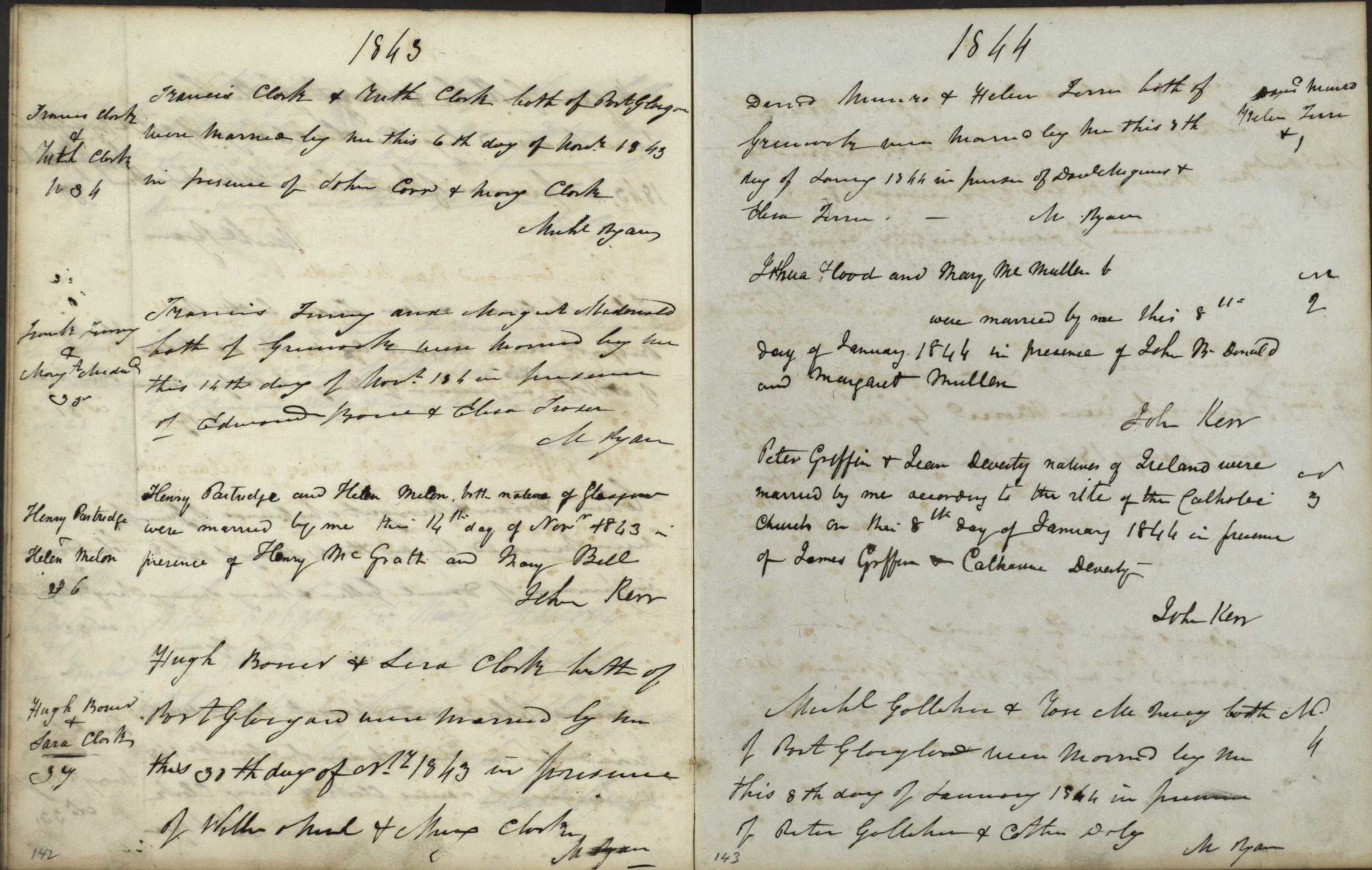
Peter Griffin and Jane Deverty's marriage record from the Catholic Register.
William Griffin, my great-grandfather, was born in Glasgow,
Scotland on 22 March 1850. William's father, Peter Griffin, ran a slating
(roofing) business in the Irish Catholic neighborhood of Calton. William's mother was Jane Griffin (nee Deverty). Jane Deverty and Peter Griffin were born in
Ireland around 1826 and migrated to Scotland during a period of significant privation in Ireland. Jane and Peter married in Greenock,
Scotland on 8 January 1844. It is likely that Peter's brother, James
Griffin, migrated with him from Ireland at the same time. Peter and James were to remain close to each other for the rest of
Peter's life.
Peter Griffin migrated to Melbourne without his wife in 1854 (his brother James migrated three years later, in 1857 on the "Herald
of the Morning"). It is unclear why Jane was left behind, however she died in the family home in Calton on 20 March 1855 (aged 30) when Peter was in Melbourne. It is likely that James brought Peter's
otherwise orphaned children with him in 1857, along with his own children.
Peter Griffin advertised as a slater in Melbourne newspapers from 1854
through to 1857, when he relocated to Bendigo. Peter Griffin slated the roof
on the first Catholic Church in Bendigo. Around 1861 the Griffin's moved back to Melbourne from Bendigo, and in 1862 the family
departed Melbourne for Dunedin, New Zealand. Peter
Griffin continued his slating business in Dunedin.
In early 1865 the Griffin family moved to Hokitika on the west coast of the South Island. Gold had been discovered in the area the
previous year. Peter Griffin advertised a painting business in
Hokitika (his occupation was frequently listed as "Slater and Painter" after this). On 18 December 1865 Peter Griffin married Sarah Crosson in Hokitika.
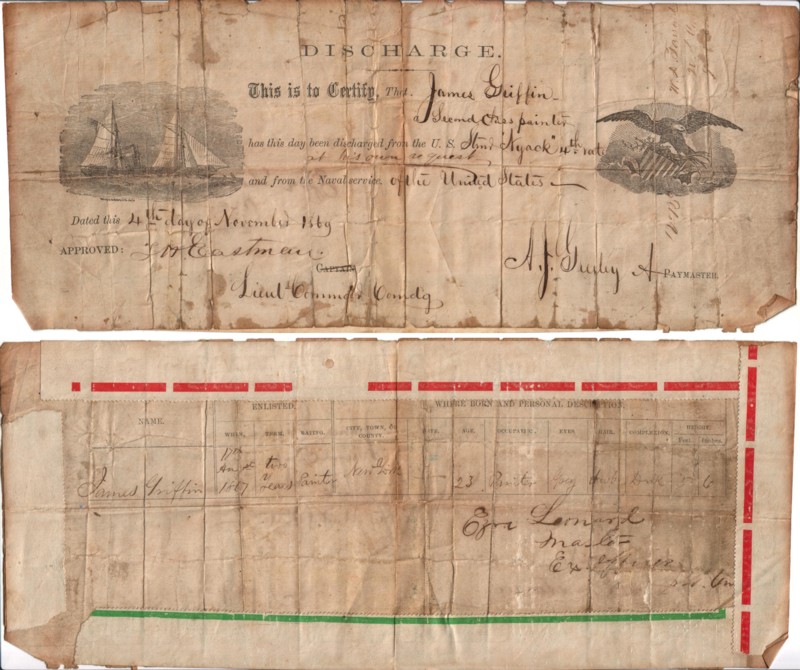
James Griffin, painter 2nd class, US Navy Discharge, 4 November 1869.
A US Navy discharge document exists for Peter Griffin's son, James, dated
4 November 1869. James (likely named after his father's brother), at age 22, enlisted as a ships painter 2nd class on the USS Nyack, a
steamer otherwise patrolling the Pacific coast of Central and South America. The Nyack had visited
New Zealand in 1867. Family oral history says that William, aged 17 at the time, accompanied his brother on the Nyack.
Around 1874 Peter and Sarah Griffin moved back to Melbourne.
William Griffin and the Chimborazo "mutiny"
William Griffin returned to Australia in 1877. Family oral history says that William "jumped ship" on arrival to Melbourne. The 28
September 1877 court case and the 29 September 1877 Argus court report tell a
different story.
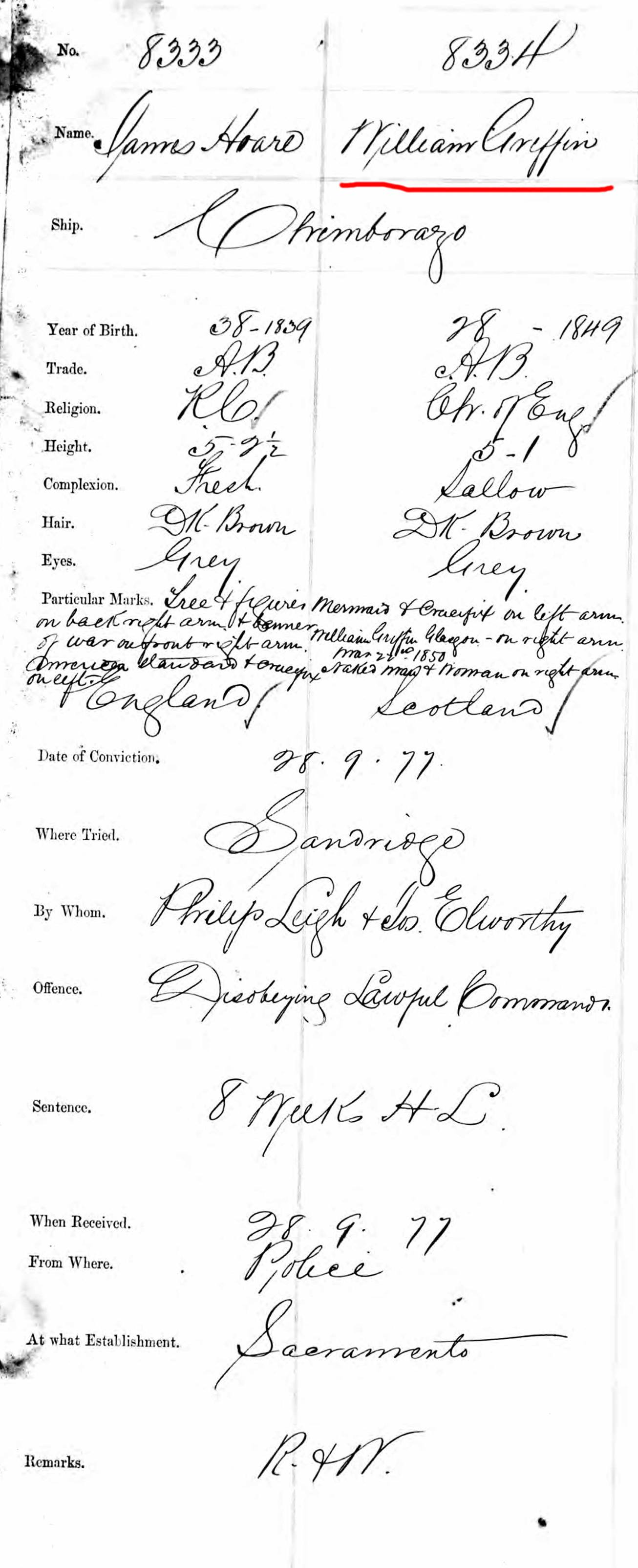
William Griffin's 1877 court record.
Able Seaman William Griffin appeared in Sandridge (now Port Melbourne) Court on the charge of failing to obey a lawful order while
working aboard the S.S. Chimborazo. The Chimborazo was an advanced steamer capable of making the run from London to Adelaide in 41
days. William was convicted and sentenced to eight weeks of hard labor at Pentridge. William's physical description appears on the
court record:
William Griffin
Height: 5' 1"
Complexion: Sallow
Hair: Dark brown
Eyes: Grey
Particular marks left arm:
Mermaid and crucifix
Particular marks right arm:
William Griffin Glasgow
March 22nd 1850
Naked man and woman
The Argus reported:
At the Sandridge Police Court yesterday seven seamen belonging to the S.S. Chimborazo were charged by the captain with having, on the
23rd September, while the vessel was at sea, unlawfully combined to disobey lawful commands. It appeared that a seaman had been
placed in irons for insubordination, and the men on both watches refused to do any work till he was released. The captain refused to
hold any conversation with them, and warned them of the result of their conduct. They still refused to work. The man was released
after some hours at the expiration of the proper period, and the men then turned to work. On the arrival of the Chimborazo at this
port, these seven men who were the ringleaders in the matter were prosecuted. Six of the number, named Burns, Oldridge, Hoare,
Wheatley, Thieborn, and Griffin were sentenced to eight weeks imprisonment, the Bench pointing out the dangerous consequences which
might have resulted from their conduct. Woodward, the seventh prisoner, was discharged, as it appeared he was working below at the
time.
It is likely that William and his brother James ran a painting business in Melbourne after this time. When William married Rachel he
listed his occupation as painter. At the time he was living in Gordon House, which was inexpensive accommodation for single men
in the CBD of Melbourne. William's brother, James, represented the Painters'
Society at the Trades Hall Council later in his life.
Peter Griffin's Final Years

Jesus only mighty to save
The dust of
Peter Griffin
who slept In Jesus 4th May 1884
aged 59 years
Waits here the morning of the
First Resurrection
"Be ye also ready"
Peter Griffin was admitted to the Yarra Bend Lunatic Asylum on
11 January 1881 by his brother James. The stated cause for (likely
involuntary) admission was "religious monomania". Peter was released on 2
May 1881. On 11 December 1883 Peter was again admitted to Yarra Bend, this
time by his son, my great-grandfather, William.
Peter remained in the asylum until he died at 11:30pm on 4 May 1884. His wife Sarah visited
him on his death bed. The cause of death was "Disease of the brain and heart". He was buried in the Roman Catholic section of the
St Kilda Cemetery.
No record of Peter Griffin and Sarah Crosson having children has been found. By her New Zealand marriage certificate Sarah was born
around 1835. She was living in a rental house in Prahran when Peter died. Her fate is unknown, there is no verifiable record of her
death or remarriage in Victoria, however a Sarah Griffin "wife of Peter Griffin, of South Melbourne, in her 86th year" who died in
Trafalgar, Victoria on 27 October 1913 was likely my 2x great grandfather's
second wife.
Rachel, William and George
On 26 July 1890 in South Melbourne Rachel Louisa Cooper (aged 16) married William Griffin (aged 40). William gave the age of 35 on his
marriage certificate, and Rachel 18. The Griffin family had a housekeeper/servant in Calton named Mary, and William Griffin lists his mother as Mary, maiden name unknown, on the certificate.
William and Rachel had seven children:
-
Lillian May Griffin - born Carlton, 1892
-
Daisy Violet Victoria Griffin - born South
Melbourne, 5 September 1894
-
Florence Ada Griffin - my father's Aunty Doll, born Melbourne,
1896
-
William Henry Charles Griffin - born South
Melbourne, 26 September 1898
-
Evelina Griffin - my grandmother, born South Melbourne, 2
March 1901
-
James Morris Griffin - my father's Uncle Jim, born South
Melbourne, 1903.
-
Valerie Amelia Griffin - born North Melbourne, 1908.
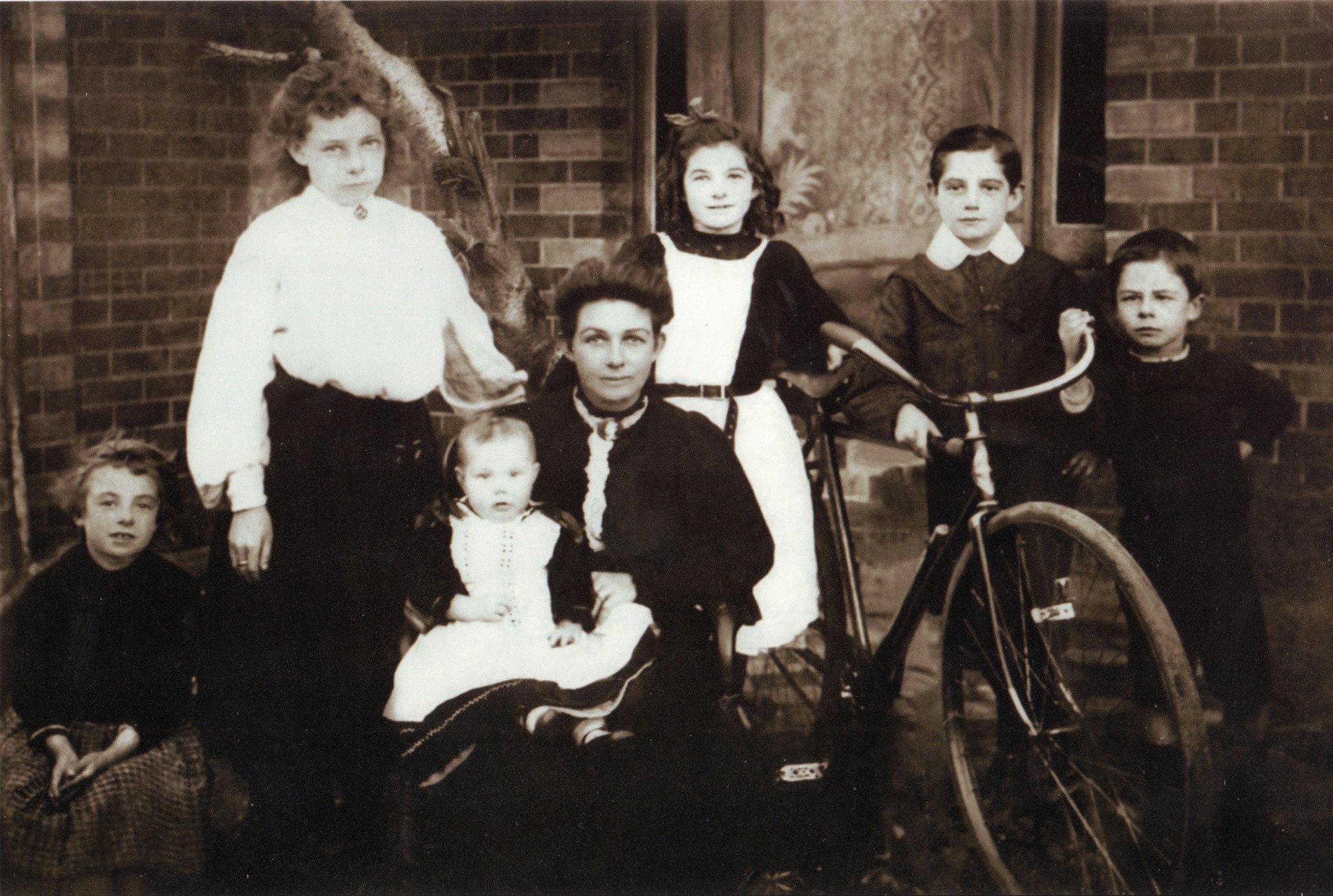
Griffin Family: (lr) Evelina, Daisy Violet Victoria, Amelia, Rachel Louisa Griffin (nee Cooper), Florence Ada, William Henry
Charles, James Morris.
Some time around 1909 the family took in a boarder by the name of George William Stap. George was born in South Melbourne in 1890 and
was about 19 years old when he lodged with the Griffin family. George had led a profoundly difficult life up until that time. His mother had died a few years before and he
may have been abandoned by his father.
Around this same time-frame (1909-1910) William Griffin, now aged about 70, moved out of the family home. On 12 June 1912, Rachel
gave birth to Ivy May Griffin in Northcote. Ivy's father's name
does not appear on her birth certificate, and Ivy does not appear as "Issue" on William Griffin's death certificate.
On 20 January 1915 at age 24, George Stap, who had been living with Rachel and her children, enlisted in the Australian Imperial
Force. George listed his Next Of Kin as "Mrs R Griffin, Foster Mother" on his
enlistment form. George went through boot camp and landed at Gallipoli as a private in the AIF on 17 July 1915. George was evacuated
from Gallipoli in January 1916 then transferred to combat in France. He was wounded twice in France and departed England for Australia
as a sergeant on 9 December 1918. On arrival in Melbourne in 1919 George resumed living with Rachel and her family, and remained living
with her through to 1945. Rachel's children with William referred to George as "Uncle George". George's occupation is listed as
Bricklayer on the Electoral Rolls during this period.
William Henry Charles Griffin
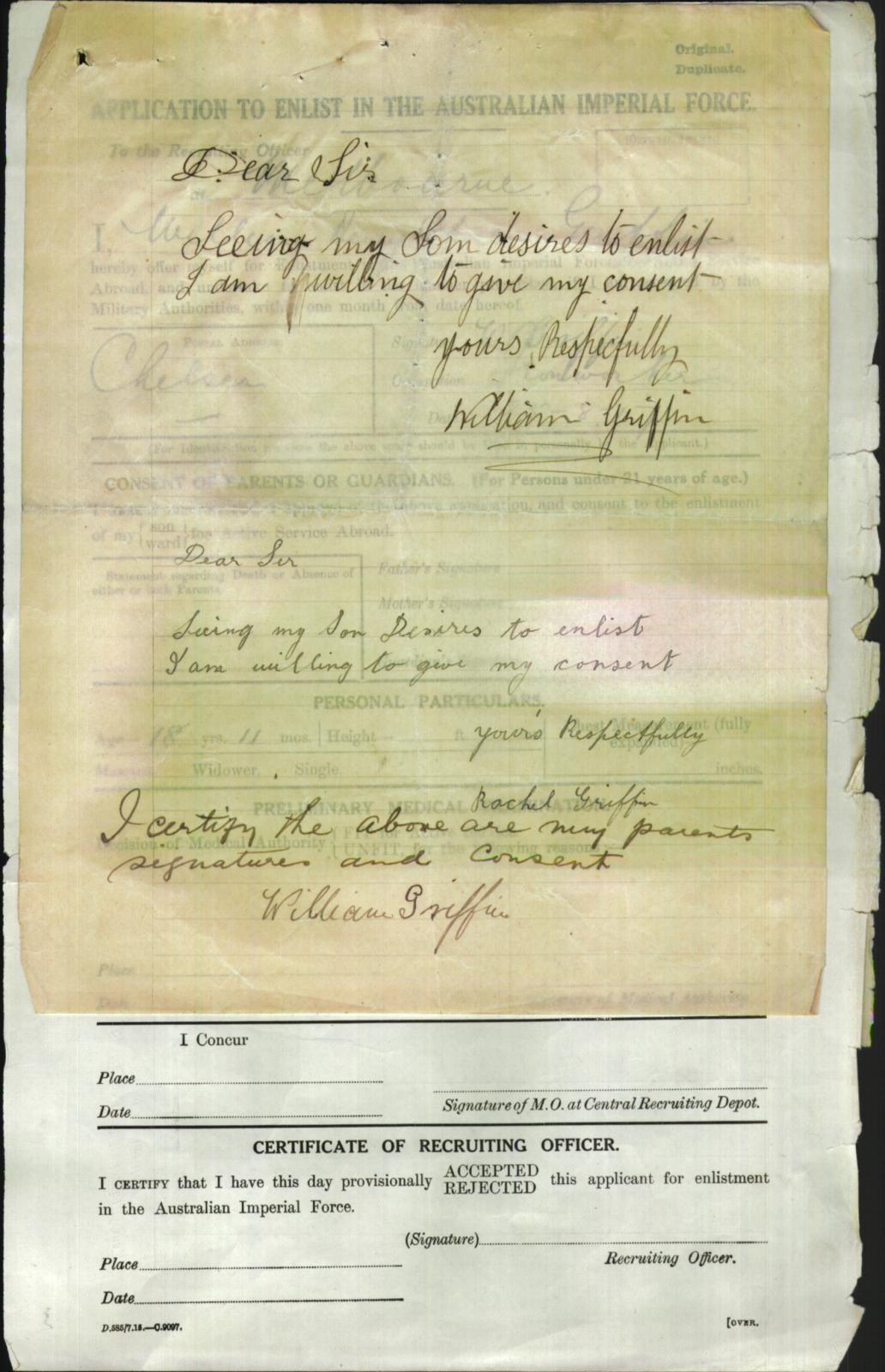
William Henry Charles Griffin's forged parental consent to the AIF.
Rachel and William's oldest son, William ("Will") Henry Charles Griffin, as with many young men of the time, was extremely eager to
fight in the AIF in WWI. Young men 18 and older and under the age of 21 were required to provide consent letters from both parents
before they were allowed to enlist in the AIF. When he turned 18, William enlisted in the AIF against the wishes of Rachel, but with
the written consent of his father, William Griffin. Will had his sister, my grandmother Evelina, who was three years younger than him,
forge Rachel's consent. The AIF accepted and filed the consent letter (see right) and William departed Melbourne on the Nestor on 10
September 1917 for England.
On 5 October 1918, on the last day of combat for his Brigade (the 6th) William died of wounds sustained the previous
day. He was buried in the Templeux-le-Guerard Communal Cemetery Extension, Somme,
France.
I have written a biography of Will's short life.
William Griffin's Final Years
William Griffin lived in a cottage, "Hokitika Cottage", in Warburton, Victoria following his separation from Rachel. Correspondence
between William and the AIF regarding his son has been scanned and is available online, and he was living in
Warburton during and after the war years. Family oral history is that he
became very religious and was involved with the Seventh Day Adventist colony in Warburton.
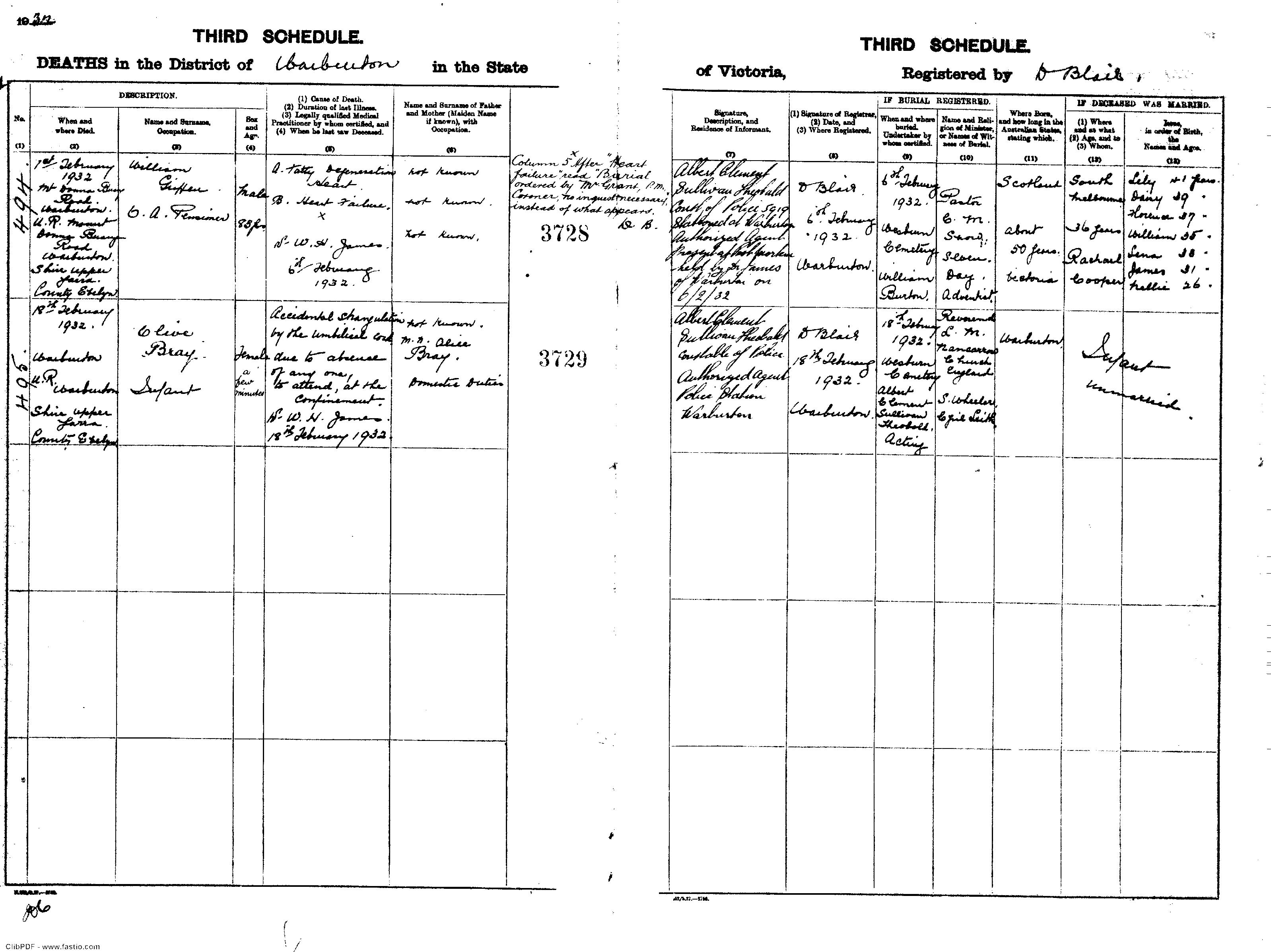
William Griffin's death certificate.
William died on 1 February 1932 in Warburton, aged 81. He was buried in an umarked grave in the Seventh Day Adventist section of the
Wesburn Cemetery; now known as the Upper Yarra Public Cemetery. The funeral
service was conducted by Charles Miles Snow, pastor of the Seventh Day
Adventist congregation in Warburton.
Rachel, George and Olive
On George Stap's return from the war in 1919, he and Rachel lived at Ella Grove,
Chelsea. Later in 1921 the family was living in Clifton Hill, in 1924 Caulfield, and by 1928 they had moved to Dunlop Avenue,
Ormond.
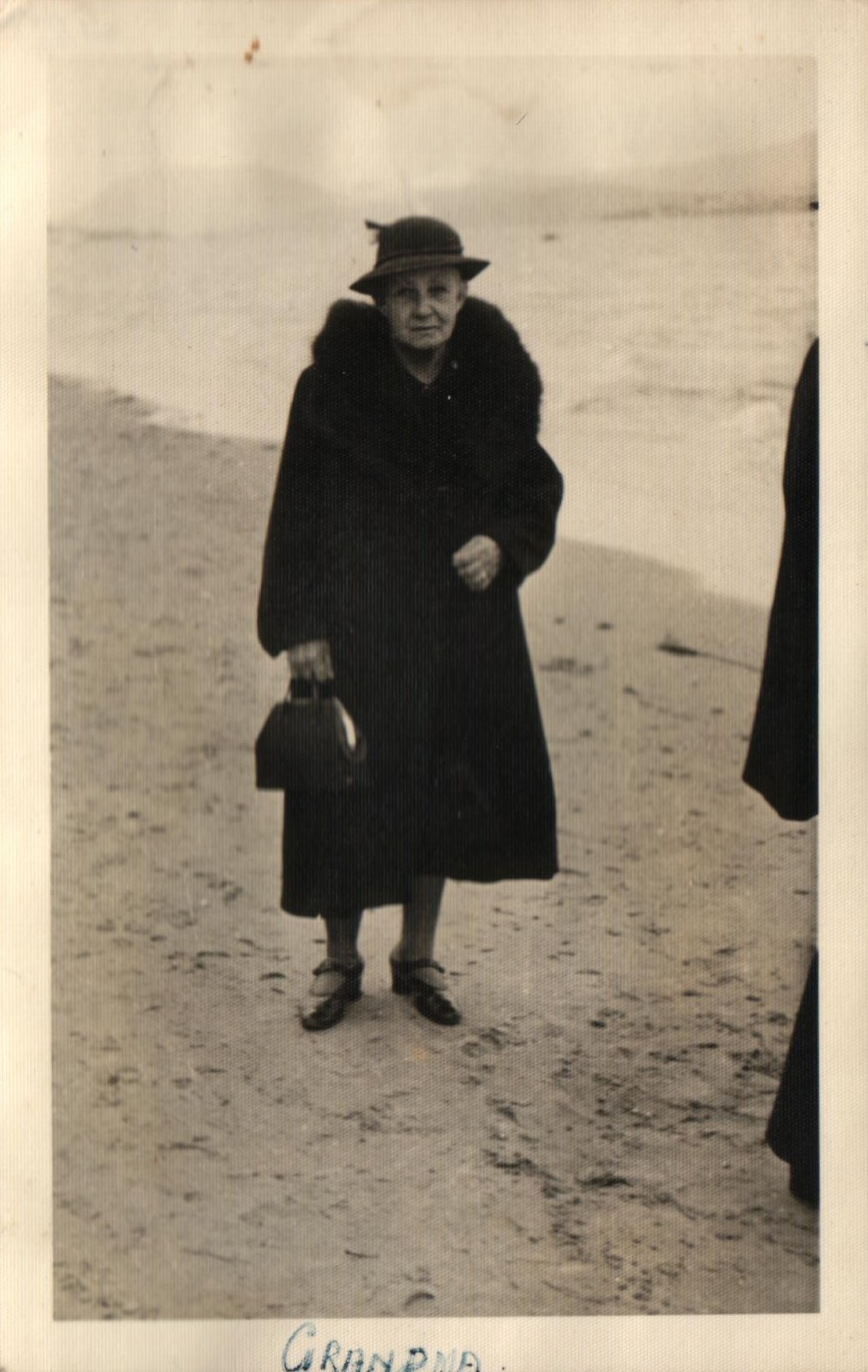
Rachel in her later years.
On 25 June 1945 George and Rachel were living on Dunlop Avenue when a lodger was tragically killed in a fire at the back of their
house; the story was published in The Argus.
Around late 1945 George married a woman named Olive Gray. George was 55 at the time, Olive was 40, Rachel was 72. George and Olive
moved to Hurstbridge and ran a small business, "The Wattle Cafe", opposite
the Hurstbridge Station.
Excluding George's years overseas in the AIF, he lived with Rachel for most of 30 years.
On 24 May 1951 Rachel died at home in Ormond at age 77. The cause of death was "cancer of the ear". Rachel was buried in
Brighton Cemetery in a plot shared with her daughter Lillian May Thomas (nee Griffin), and Lillian's son William Henry Charles Thomas who had both predeceased her.
Family oral history says that George was cut off from the Griffin family when he left Rachel. Likewise, George and Rachel's
daughter, Ivy, had fairly limited contact with her mother and half-siblings. However, when Rachel was on her death-bed, George was
called and he visited and they reconciled just before Rachel's death.
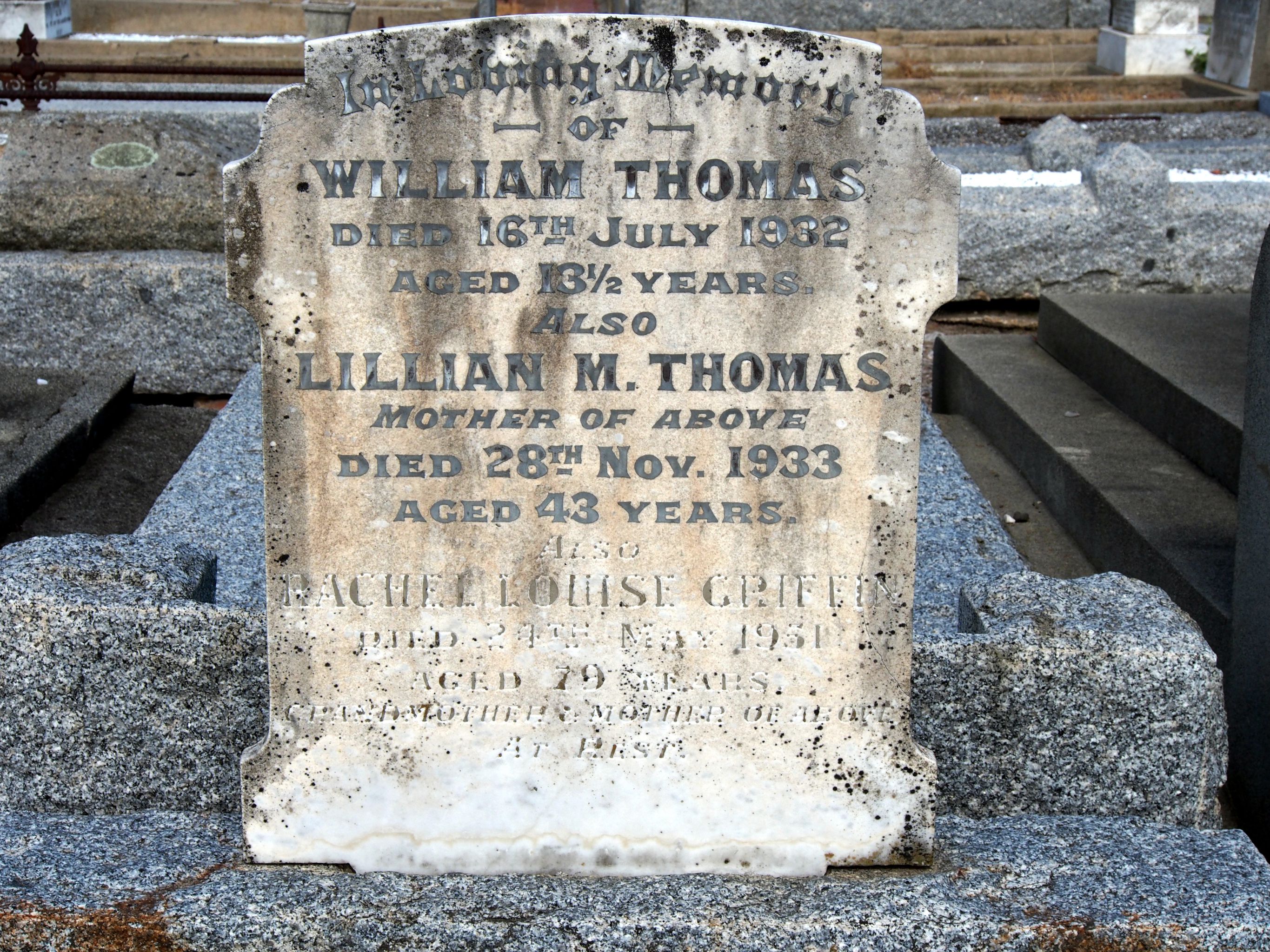
Headstone of Rachel, her daughter Lillian, and her grandson William.
George died at the former home of his in-laws in Glen Iris on 19 February
1953. Olive inserted In Memoriam notices in The Argus for several years after
his death. Olive died in Donvale in 1973 and her and George's remains are interred in the same plot at the Springvale Botanical
Cemetery.
Acknowledgments
Many people and organisations assisted in accumulating and verifying the information and images for this page.
- My sister Cindy, my late father (Rachel's grandson) Wallace Campbell
- Cousins Christine, Fiona, Kate, Tim, Bev, and Jan. My Aunt
Joan
- Cousin John Griffin
-
The National Archives of Australia
-
Trove (National Library of Australia)
-
Papers Past - The National Library of New Zealand
- Indexed census returns, birth, death and marriage certificates, and electoral rolls at Ancestry.com
-
State Library of South Australia
-
Scotlands People - The National Records of Scotland
-
Births, Deaths, Marriages - Victoria
-
Glasgow Post Office Directory Archive - The National Library of Scotland





























